
There is no doubt that metal weatherstripping is one of the best choices for air-sealing wood windows and doors, but which one should you choose? I’ve been restoring wood windows and doors since 2010 and have tried all types of metal weatherstrip and I want to share my years of experience on the topic so you can make a better decision
Compared to other types of weatherstripping like felt, vinyl, or rubber, metal weatherstripping is an extremely durable option that rarely if ever needs replacing. That makes metal weatherstripping the best option for an extremely long-lasting installation (we’re talking 100+ years for any of this stuff!) that you can set and forget on both windows and doors.
Some metal weatherstripping is incredibly DIY-friendly to install and others are a pain the sash. But all of them are by far the most effective weatherstripping on the market despite the higher costs than the throw away materials most people use.
In the sections below I’ll describe the each type of metal in-depth and share some tips and tricks for when to use them no how to install and work with them. Let’s dive in!
What is Spring Bronze?
Spring bronze is one of the oldest forms of weatherstripping and most DIY-friendly. It is sold in rolls of 100 feet typically and can be used to weatherstrip wood doors, double-hung windows, single-hung windows, casement windows, and a slew of other types of wood windows. The installation process is fairly straight forward but can be tedious because it involves installing dozens of nails to hold the bronze in place.
It can be purchased in different widths ranging from 3/4” to 1 3/4” wide, but I have found that in most cases 1 1/4” is a fairly universal size that can be used in almost all applications. Installing spring bronze involves cutting around hinges, latches, pulleys and any other obstruction in the jamb of the window or door which takes some precision and time.
Spring bronze can be used to resolve gaps as small as 1/16” to about 1/4” successfully Though it can be “sprung” at times to resolve larger gaps it does not perform as well in gaps larger than 1/4”.
The most time consuming aspect of spring bronze is that it must be nailed approximately every 1 1/2” to 2” along its entire length using either copper-dipped steel nails or solid bronze nails (solid bronze nails are required in coastal regions). That’s a lot of nailing and it can be frustrating if you’re not good with a hammer as you can easily end up with bent nails and dinged bronze in that hard old-growth wood. You can purchase spring bronze in varying lengths in our store here.
The Most Efficient Way to Use Spring Bronze
Over the 15 years I’ve been restoring windows the cost of bronze has gone up ridiculously (as have many metals). Spring bronze is typically sold in rolls of 100 feet which, for some folks, can be a lot more than you need. You’re stuck paying for a bunch of bronze you don’t need.
To combat that we started selling spring bronze cut to size for our customers. Now you can get that sweet spot 1 1/4” spring bronze and only pay for what you need in increments of 10 feet. My hope is that it will save a lot of people money on their weatherstripping and encourage folks to seal up those old windows with a lower cost barrier to entry.
Pros
- Easy to store and transport compact 100’ rolls
- Excellent for sealing 1/16” to 1/4” gaps
- Very attractive
- Can be easily adjusted to fit gap size
Cons
- Requires lots of precise nailing
- Easily kinked if not installed straight
- Poor air-sealing of gaps larger than 1/4”
How To: Install Spring Bronze
Of all the types of metal weatherstripping mentioned in this post I will tell you that from my experience Spring Bronze is by far the easiest for a DIYer to install. It requires no specialized tools like some of the other types of metal. It’s not a cake walk and requires precision, but is far more forgiving than some of these other options.
Below you’ll see the steps with pictures to install spring bronze on a door and then a video of the spring bronze installation on a wood window.
Tools Needed:
Step #1 Cut to Size
Measure the door openings and using tin snips cut the weatherstripping to length. The weatherstrip needs to go in the rabbet that the door fits into when closed. There is a flat side and sprung side to spring bronze. The flat side goes on the interior and the sprung side faces the exterior so that the door compacts it as it closes.
You’ll need to cut the bronze so that it doesn’t cover and interfere with the hinges or latches.
 Step #2 Nail in Place
Step #2 Nail in Place
Line up your spring bronze and nail it in from the top down. Make sure you start from one end and keep the bronze straight the whole length so it does not bubble or bind in places. Also, be careful not to nail the bronze too close the the door jamb (see spacing in photo) or it may not be able to lay down completely when compressed.
Your nails should be no more than 2” apart. I prefer 1 1/2” between nails to make sure the installation is lasting. Some people prefer to pre-drill the bronze, but I find that unnecessary if you’re good with a hammer.
Corners require the weatherstripping to meet at simple butt joints.
The nails should be flush with the surface. Run your fingers across them and if you feel any that are standing a bit proud, set them a bit more with a nail set.
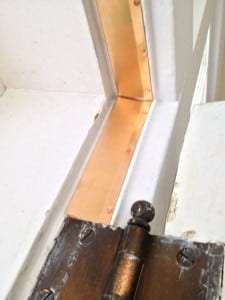 Step #3 Adjust the Fit
Step #3 Adjust the Fit
Depending on how tight the existing door is in the frame, you may need to increase the spring angle on the weatherstripping or “spring” the bronze to fill the gap.
Use a wide 4” putty knife or 5-in-1 tool to gently bend the bronze to increase the tightness of the fit. Close the door and check for any gaps where you can see sunlight. If you do, open the door and keep going until all light is blocked.
Alternative Installation
Sometimes I have come across windows where the jambs are just too loose and beat up to nail anything even with pre-drilling. In these cases, I have resorted to a battery narrow crown stapler to install the bronze. I’m not going to lie, it goes MUCH faster! But there are a few things to be careful of if you decide to go this route.
- Use only 3/4″ stainless steel staples – Anything longer than that can get in the way of the moving weights behind the jamb. These nails will be exposed to the weather so if they aren’t stainless, they will rust and loosen their hold in a short time. Also, anytime you put two different types of metal together, you run the risk of galvanic corrosion which causes the metals to rust and corrode prematurely.
- Test the depth on your nailer – It is very easy to blow right through the thin bronze with a battery or pneumatic stapler. Test a few strips to find the right air pressure and depth.
- Still put a nail at the top and bottom of the bronze. The coppered nails hold better than pneumatic staples will. The two spots that are most likely to pull away are the end of the bronze so put a nail in those spots to make sure it doesn’t pull away in the future.
There is also a strip of bronze that can be installed at the meeting rails between the two sashes, but I rarely use it since I have found that by simply adjusting the sash lock, I can achieve a good enough seal to avoid this added expense.
What is V-Bronze?
V-bronze, sometimes called “cushion bronze” is extremely similar to spring bronze except that its form is essentially an extra wide spring bronze that is doubled over on itself. This type of weatherstripping is extremely effective at resolving larger gaps from 1/8” upwards to 1/2”.
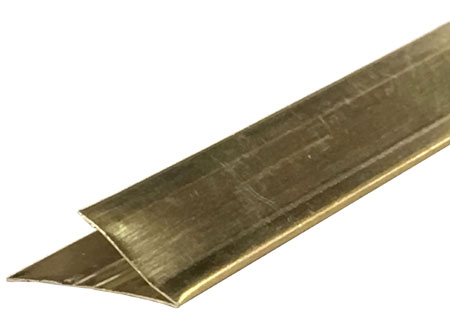
It is sold in specific straight lengths, the most common of which are 3, 4, 7, or 8 foot lengths. Unlike the roll of 100’ like spring bronze you have to specify a length of v-bronze when you order and you may end up with more waste because of that.
Like spring bronze it is also available in a variety of widths ranging from 1/2” to 1 1/8” of which I find 3/4” to be the most useful and a happy compromise since it can fit in most applications and avoids overlapping of elements within the jamb like the larger widths do.
Due to its design, v-bronze requires fewer nails than spring bronze which is a welcome relief to many installers. Even though manufacturers still recommend nail spacing in the 1 1/2” to 2” I have found in practice that nailing once every 8” to 10” and one on each end is more than sufficient to hold it securely in place. Trust me and save the nails. You’ll want to use them same special coppered or bronze nails as with spring bronze for installation.
Pros
- Easy to keep perfectly straight at installation
- Excellent for sealing 1/8” to 1/2” gaps
- Available in more narrow 1/2” width for tight spaces
- Simplified nailing compared to other options
Cons
- Generates more waste due to pre-cut sizes
- Will not fit gaps smaller than 1/8”
- Requires caution to transport without bending or damage
How To: Install V-Bronze
There is very little difference in the installation techniques between spring bronze and v-bronze except for the nailing patterns. With v-bronze you can follow the exact installation instructions above, but use the image below of a properly nailing setup as a guide for you.
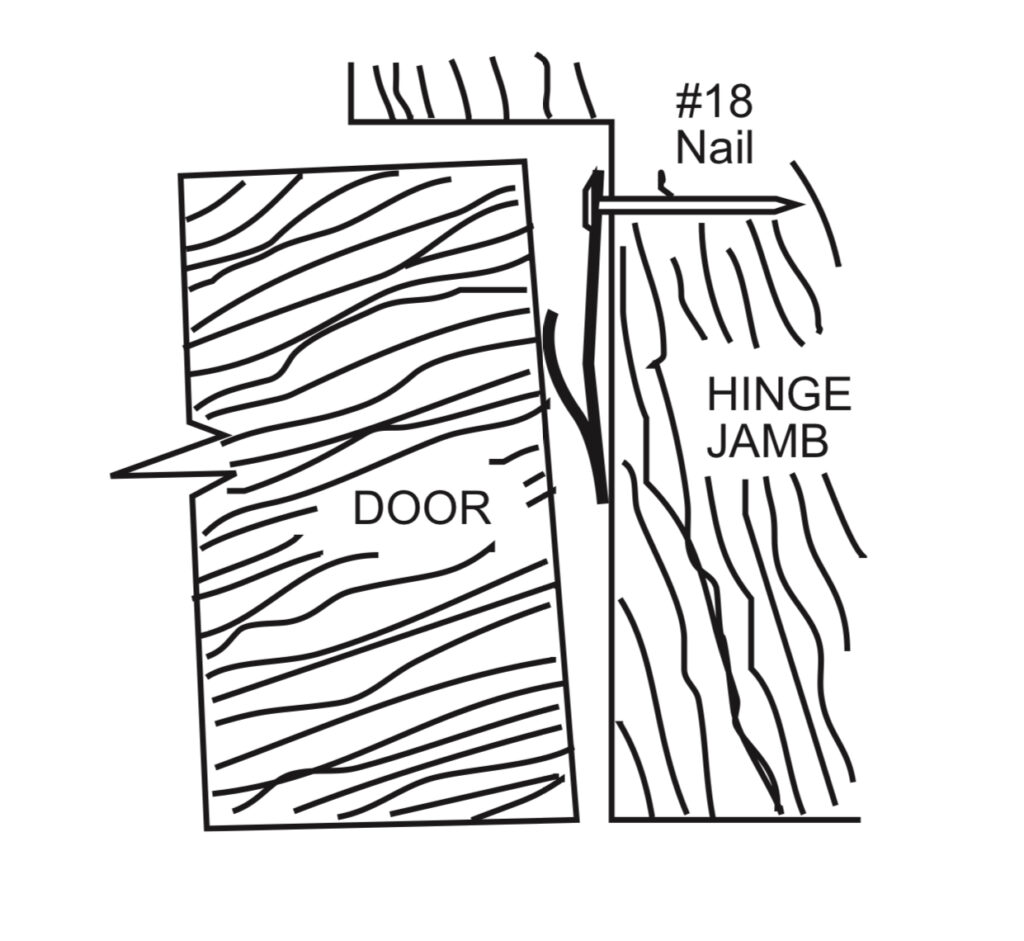
Interlocking Metal Weatherstripping
Interlocking metal weatherstripping (sometimes called integrated metal weatherstripping) is the mac daddy of the weatherstripping world. It is extremely effective, very long lasting, and pretty dang difficult to work with.
Of all the metal weatherstrips mentioned so far this type is by far the best at air-sealing (aka draft blocking). Your return on investment for this type of weatherstripping may be long in coming though since the cost of installation can be steep. Interlocking metal can cost $300-500 to install new as opposed to spring bronze which can run about half that much.
Installing new integrated weatherstripping on a window that did not previously have it is beyond the scope of this post, as it requires precise modification of the sash with routers and very careful templating which in IMHO should be left to a pro.
However, restoring a window with this type of weatherstripping requires some additional knowledge that I can share with you about how to safely remove and reinstall both the sash and weatherstripping without damaging the weatherstripping. That way you can reuse it and reap the benefits. Let’s look at some of the tools you need to get the job done properly.
Tools Needed:
- Hammer
- Trim Pry Bar
- 5-in-1 Tool
- Needle Nose Pliers
- Nail Set
- Cat’s Paw Pry Bar
If you’re a more visual learner, and who isn’t these days , then you can see the whole removal process in action in the video below. I don’t cover the whole restoration process of the window jamb and sash in this post or video, but you can watch the whole step by step process in my intensive, self-paced teachable course called The Window Course where you get all the goods on restoring historic windows.
How to Remove Window Sash
It would seem that a sash with this type of weatherstripping are permanently stuck in the jamb since it appears to be trapped in the weatherstripping fins on the sides, but that is not the case. There are just a few more steps before you can remove the sash without damaging it.
The first step to any of this is to have both sash cut free of excess paint or caulk, because the sash need to be able to be moved up and down during this process to access the nails on the metal weatherstrips. So, start with getting the sash at least somewhat moveable again if they are stuck, and then you can proceed with removal.
If you’re not sure how to do that then checkout my resource page DIY Window Restoration for detailed instructions. In this post my focus is on the special consideration for working around this unique metal weatherstripping.
Step #1 Remove Stops
Just like on any other other sash, remove both interior stops by scoring the paint and prying them off the jamb.
Step #2 Remove Lower Sash & Weatherstrip
Make sure the bottom sash is in the lowest position possible so that you can access the the top portion of the metal weatherstrip on each side of the bottom sash. You should see one small nail at the top of the metal. Slide your flat pry bar or 5-in-1 behind the weatherstrip in this area and gently pry the metal out so that the nail pulls out from the surface a bit. Then, push the metal back, leaving the head of the nail proud of the surface enough that you can pry it off with your cat’s paw pry bar or a pair of needle nose pliers.
You have to be gentle with this weatherstripping because it is very thin zinc, which is relatively soft and can tear and bend easily.
Once the top nail is removed on both the right and left side of the jamb, raise the lower sash up enough to reveal the lower nails (usually just one or two toward the bottom) and follow the same procedure above to pull the nails out.
If you can’t get these nails to pry out, then the fail safe option is to use your nail punch to punch them into the wood through the weatherstrip so that the weatherstrip is now free of the nails. It may have a small nail hole in it, but that won’t affect the performance.
Once both weatherstrips are free, you should be able to slide them up over the stool and get the sash out of the jamb along with the weatherstrips. Cut or disconnect the ropes and your bottom sash is free. Label everything so that you know where it goes when you reinstall.
Step #3 Remove Upper Sash & Weatherstrip
Start by removing the parting bead on both side of the jamb, then make sure the top sash is in the uppermost position and using the same procedure above, remove the two lower nails from the weatherstrip on each jamb. There should be enough space to use a cat’s paw to pull the nails out once they are clear enough from the surface.

Lower the upper sash to reveal the one or two upper nails, which will be located near the top of the jamb and around the pulley. Pry and remove these nails the same as before from both sides.
Cut or disconnect the ropes and remove the upper sash from the jamb along with the weatherstrips. Be carful that the weatherstrip does not fall, as it can be harmful to you or to the sill, stool, or hardwood flooring upon impact. Mark the location on the backs of each piece.
Step #4 Restoration of Weatherstripping
Once you have the sash out, you are ready to follow the sash restoration process that I teach in The Window Course with a couple of additions. There will likely be an interlocking piece of metal weatherstripping on the meeting rail of both sash that mates when the sash are closed.
I leave these in place because there is no reason to remove them. They can be cleaned up and realigned to make sure that they fit into each other without kinks or other problems. These can be easily bent if you’re not careful and before installation, double check to make sure that they are still lined up and free of any paint or other gunk that would impede operation.
I also leave the piece of weatherstrip on the top of the jamb and on the sill to be cleaned of paint in place and sanded smooth again. There is no reason to remove it and it usually causes more issues when it is removed because you’ll need realign everything later.
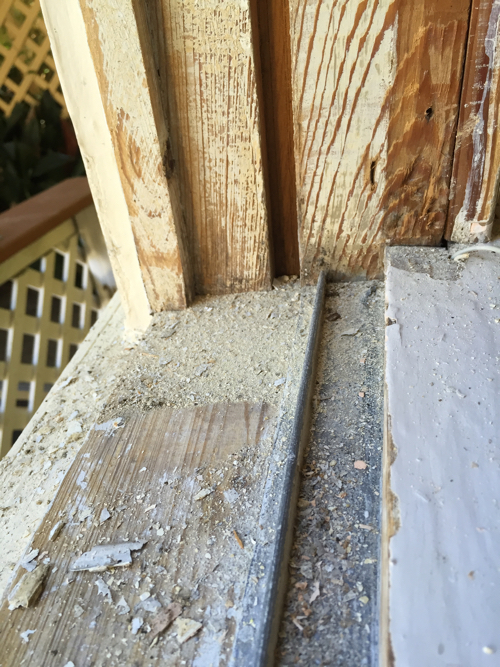
I also take this time to clean up the old weatherstripping with 0000 steel wool to clean off any paint or dirt and make them more attractive and ease the operation when they are reinstalled. Bend back any kinks and get them ready to go back in.
Step #5 Install Upper Sash & Weatherstrip
Installation is made much easier with a helper to hold things in place. You can do it on your own, but it sometimes feels like you need three hands.
Start by installing both the upper and lower sash weatherstrips on one side of the jamb first (only do one side!) Nail them back where they went using the same or similar sized nails as they were originally attached with and nail in the same locations roughly. Then, install the parting bead on that same side.
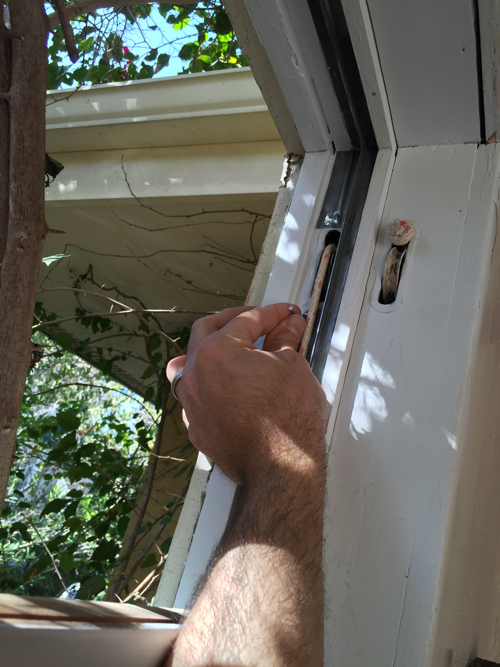
Attach the ropes to the upper sash on both sides. Tack the rope in place on the sash with a nail for added security to keep it from pulling out.
While holding the loose piece of weatherstrip in the groove along the edge of the sash, slide the sash into the weatherstrip previously nailed onto jamb and pivot the sash into place against the blind stop. The loose weatherstrip should be pushed to the top of the jamb and fit against the weatherstrip on jamb header. Nail off the top of the weatherstrip at the top and around the pulley like it was previously attached.
Raise the sash all the way up and nail the bottom portion of the weatherstrip. Insert the remaining parting bead and test the operation of the top sash.
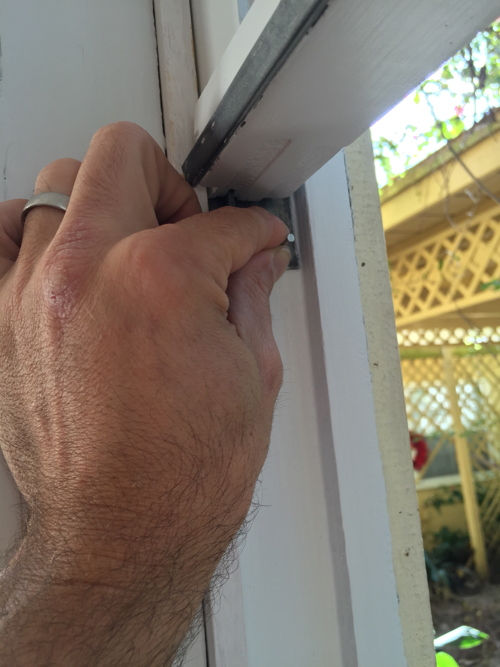
Step #6 Install Lower Sash & Weatherstrip
Following much the same procedure as above, attach both ropes to the lower sash and tack the rope in place with a nail for security.
While holding the loose piece of weatherstrip in the groove along the edge of the sash, slide the sash into the weatherstrip previously nailed onto the jamb and pivot the sash into place against the parting bead. This time, the loose weatherstrip should be pushed to the bottom of the jamb and fit against the weatherstrip on the sill. Nail off the bottom of the weatherstrip where it was previously attached.
Lower the sash all the way to the sill and put a single nail in the top of the bottom weatherstrip. This one is usually a tight fit, so a nail set is best for getting this nail fully set.
Check that all nails are fully set but not punching through any of the metal weatherstripping.
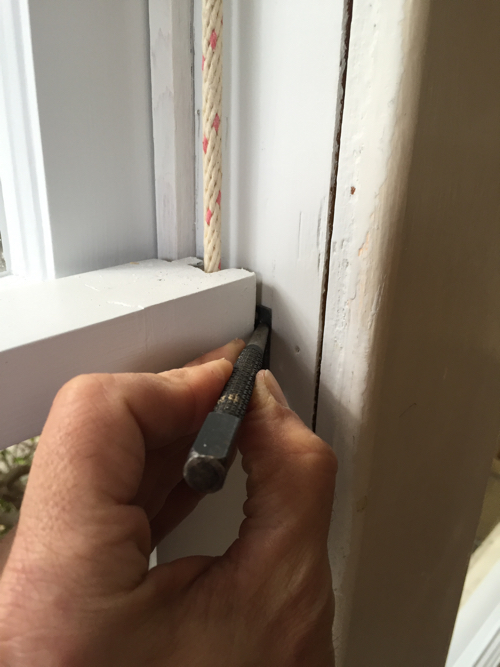
Install the two interior stops and then test the operation of both sash to ensure that you’ve got a smooth up and down. If you need to tweak the fit of the interlocking pieces on the meeting rail so the sash close fully, this is a good time. Also, it’s possible that the alignment is not perfect for the sill and header piece of weatherstripping that you left in place. They may also need to be tweaked a bit as well.
Lock Strip Metal
This unique little piece of weatherstripping is designed specifically to seal the lock set on a door since you cannot install spring bronze, v-bronze, or interlocking metal in this place. Lock strip 27b (not the coolest name, but it works) comes in lengths of 1-3 feet and needs only 2-4 nails depending on the length of piece you use.
The installation is pretty effective at sealing this joint and not getting in the way of the operation of the door, but I have also used it effectively to weatherstripping double hung windows too. Let me tell you how I do it.
Sometimes double-hung windows get “slop” in them meaning they are too loose front to back. Spring bronze and v-bronze can resolve side to side slop but not front to back. That’s where the lock strip comes in.
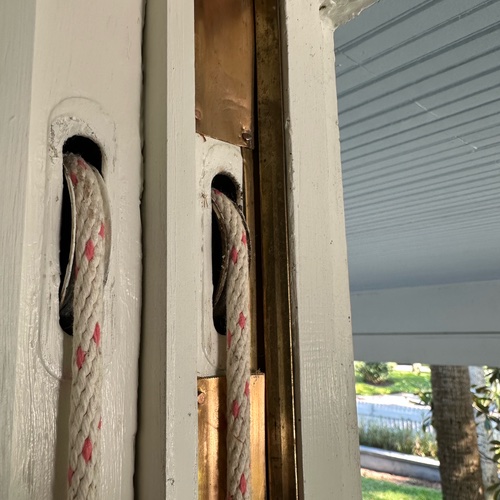
You can install install a length of lock strip on the window jamb on the backside of the blindstop like in the picture above to resolve the front to back slop and also seal against the pulleys which no other weatherstripping can effectively do.
I haven’t tested the efficiency of it, but I would venture to say that it could be used in place of any other type of metal weatherstripping to effectively seal wood windows with minimal effort. I’ll be testing it soon and let you know the results.
Final Thoughts
For the money, metal weatherstripping really is the best you can get. It’s as effective in year one as in year 100 and there aren’t many products that can make that claim and live up to the hype. If you’ve got wood windows or doors I would recommend using any of these products to seal them up and achieve the incredible efficiency these windows and doors really are capable of.
For historic windows and doors you can find all your weatherstripping needs as well as any other old house tools and supplies in The Craftsman Store so stop by and take a look around to make your restoration project easier today.

Founder & Editor-in-Chief
I love old houses, working with my hands, and teaching others the excitment of doing it yourself! Everything is teachable if you only give it the chance.




I’m working on a metal door frame with existing holes
Any suggestions
Spring bronze will not work on a metal jamb as it is nailed on.
Very true!
Hi there. If I buy the v shaped weatherstripping and it’s not as wide as my jamb channels, where within the channel should I nail it? Flush against the parting bead (minus the match width)? Or should it be back more in the middle?
Thanks
Where should you put the bronze weather stripping on a double-hung sash window?
If I butt the spring weather stripping to the edge of the hinges, do I need to put some type of weatherstripping behind the exposed hinge? Thanks
Hello, and thank you for all the great tips and sharing of skill and knowledge. I do have a couple of questions. Obviously, there is no school like the old school and I find that it is a nightmare going to the hardware store with all of the vinyl and adhesive crap they sell which in my opinion doesn’t work well at all. So here are my questions:
1. There are two types V and flat springbronze plus numerous sizes. Is there a General size and type that an old school pro would typically use that covers the majority of door frames?
2. Many of the newer prehung exterior doors come with a vinyl seal that the door presses against that sort of makes a seal…however, if I can see daylight through the cracks or feel wind I know that it is a poor seal. Do pros use spring bronze in addition to the crappy factory seals or is always typically removed first?
Mary Ann, 6′ spring bronze comes in widths starting @ 3/8″
I figure this should be a place to share advice after living through the process. Killian says to space the bronze a matchstick from the stop. Well, matchsticks are no longer uniform and pretty. They should be 3/32. I found out that the free fancy vinyl samples from home depot is the exact thickness. I grabbed one, cut it into quarters then super glued it to a scrap of parting bead (put the parting bead in place, then glue). Slip it in and butt the bronze up. perfec,t even spacing every time.
Hello, and thank you for this tip. Can you please tell me a little more about the vinyl piece that you mentioned is? Also, do you have any pro tips about the lock area?
My home was built in 1929. I just opened up two swing-out casement windows that were painted shut for probably 50 years. The weather stripping looks in good shape but both catch on the windows when I close them. Is there a recommended way to bend the metal back where it should be so the window will close without sticking?
Hi, I found your blog as I have an 140 year old house that I have just noticed has bronze weather stripping on the door. I notice it because the bronze has split along various points where it is bent and has now started to interfere with the door closing properly, calling my attention to it. So I thought I would try to replace this myself. The installation seems straight forward enough. One question i have is do you have a suggestion on getting the many many copper nails out, that are, as described, set well flush with the door jamb, and there are alot that will need to come out to re-do this. Any advice would be appreciated. Thank You. Margaret Malone
Rarely do I even try to remove the nails when reinstalling spring bronze. Rather set them flush with the surface and install the new bronze over them to hide them.
while my windows are not original (2 over 2), they are unique and quite thin. Sashes are not even 1 inch in depth. Is there spring bronze that narrow and if not, what would you suggest?
Firstly, thanks so much for this blog! It has is a fantastic source of information and inspiration. I have a question regarding the installation of spring bronze weatherstripping on a pair of outward opening double doors. One door is used daily while the other is stationary 90% of the time. I understand how to weatherstrip around the door jambs but what would suggest for the gap between the two doors? There is an exterior astragal, but there is still a lot of airflow there. Your advice will be very much appreciated. Many thanks!
I am purchasing Pro Spring Bronze for a wood double hung window. 1910 built home. I believe there needs to be room for the spring bronze to compress, just not sure how much.
Window channel is 1 3/8 wide, should buy the spring bronze 1 1/4″ roll or the 1 1/8″ roll?
For our setup, I prefer to install two lengths of spring bronze on either side of lower sash jamb, one on the top portion of fixed jamb, and one on the removable portion of jamb weight pocket door.
I work in architectural restoration and have installed a lot of this stuff over the years. Yes, spring bronze is a good form of weather-seal that has been around a long time—more than a century, I would guess (from houses I’ve worked on). I do want to offer one correction, though. Your description says “Installed properly it will never need replacing…” Well, that isn’t quite true. Metal does fatigue over time. Yes, it lasts a long time, especially if you buy high quality material (not the junk you can get in your local hardware store…name starts with “A”). But it doesn’t last forever. If you’ve got old spring bronze that doesn’t “spring” when you bend it, you aren’t getting a good seal on your door or window. I recommend replacing it when it is fatigued.
I have an old Craftsman style home built in the 20s. former owner had all windows sealed shut…uggg I need
windows open in the summer. I’ve used a heat gun to get the caulking off some windows. in the winter I stuff felt strips to help keep the cold air out. helps some, not great. The doors are another story. Gaps are much wider in some areas than others. Is there a demo of how to install spring bronze weatherstripping? There are several windows that swing in, the rest are double hung with weights…air gets in through the rope channels too.
Can B74 94 v-cushion weatherstrip be installed to an arched head jamb
I haven’t tried V-bronze on an arched top so I’m not sure but I do have plenty of experience with spring bronze on the arched head jamb and it works very well.
How do you install the spring bronze on a ln arched frame?
You have to cut kerfs in the bronze every 1” or so depending on the radius of the curve. I outline the process in my book Old Windows In-Depth.
Can you get 18 ga copper brads collated for a brad nailer like Harbor Freight has?
Is there any particular reason to use coppered nails? Could (say) 18 ga brown head nails work as well?
I haven’t found any for a pneumatic nailed yet. You have to use copper or bronze to prevent galvanic corrosion which occurs when you put two dissimilar metals together.
I understand how to use spring bronze on double hung, doors and in swinging casement windows. Is there any way to use spring bronze effectively on out swinging casement windows? How do I weather strip them?
Melinda Lee
Outswing windows just turn the nailing flange around so that it faces the outside of the house. That way the casement will slide right in.
If you have old spring bronze that have been painted is there a safe way to take the paint off? Like Cleartrip? Would removing old paint help to regain some of the weather stripping effectiveness?
Chemical stripping should work on old spring bronze. And it won’t add much efficiency unless it was really gummed up.
re: bronze weather stripping….I used a knife tip to carefully chip off the larger chunks of paint, then steel wool for the rest. Went over it with noxon and now they look great! House is 95 years old….the stripping is on two French doors leading to an enclosed porch. It’s amazing what a tight seal this stripping creates. I’m also retired so have the time to do stuff like this! Took about 8 hours for both doors. I’m trying to bring a once neglected home back to original….fun way to spend my remaining years!
Hi,
I have existing bronze metal weather stripping on my front door of a house built in 1940. When the wind blows high the weather stripping vibrates and is extremely loud. When I first moved into the house, there was a wind storm and I thought my front entry was going to collapse. Any thoughts on how to adjust the stripping so it doesn’t do this?
Jamie
I have an interior door to the garage and when the wind really blows there is a shrill noise generated from the vibrating metal. Any fixes for that?